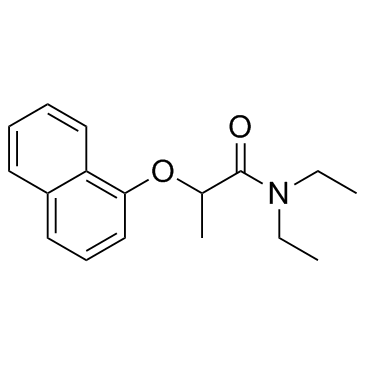Napropamide

Napropamide structure
|
Common Name | Napropamide | ||
|---|---|---|---|---|
| CAS Number | 15299-99-7 | Molecular Weight | 271.354 | |
| Density | 1.1±0.1 g/cm3 | Boiling Point | 430.2±28.0 °C at 760 mmHg | |
| Molecular Formula | C17H21NO2 | Melting Point | 73-78 °C(lit.) | |
| MSDS | Chinese USA | Flash Point | 214.0±24.0 °C | |
|
Multiresidue method for the determination of 13 pesticides in three environmental matrices: water, sediments and fish muscle.
Talanta 85(3) , 1500-7, (2011) Pesticides residues in aquatic ecosystems are an environmental concern which requires efficient analytical methods. In this study, we proposed a generic method for the quantification of 13 pesticides (azoxystrobin, clomazone, diflufenican, dimethachlor, carbe... |
|
|
Picloram and napropamide sorption as affected by polymer addition and salt concentration.
J. Environ. Qual. 31(4) , 1234-9, (2002) Polymer application to soil is a growing practice to improve soil physical properties and reduce soil erosion. Polymer addition can potentially influence herbicide and pesticide sorption in soil. The one-point distribution coefficient Kd values of two herbici... |
|
|
Impact of soil amendments on broccoli quality and napropamide movement under field conditions.
Bull. Environ. Contam. Toxicol. 75(4) , 797-804, (2005)
|
|
|
Napropamide residues in runoff and infiltration water from pepper production.
J. Environ. Sci. Health B 40(3) , 385-96, (2005) A field study was conducted on a Lowell silty loam soil of 2.7% organic matter at the Kentucky State University Research Farm, Franklin County, Kentucky. Eighteen universal soil loss equation (USLE) standard plots (22 x 3.7 m each) were established on a 10% s... |
|
|
Fate of napropamide herbicide in selected Malaysian soils.
J. Environ. Sci. Health B 47(2) , 144-51, (2012) This study was carried out to determine the sorption-desorption, degradation and leaching of napropamide in selected Malaysian soils. The sorption capacities of the selected Malaysian soils for napropamide were the following in descending order: Linau > Terin... |
|
|
[Characterization of napropamide enantiomers by CD and determination of the enantiomeric ratios in water].
Guang Pu Xue Yu Guang Pu Fen Xi 26(9) , 1649-52, (2006) The enantiomers of napropamide were separated by normal phase HPLC (HPLC: high performance liquid Chromatography) with Chiralpak OJ-H column and charactered by circular dichroism. On this basis, a method for the chiral separation and micro-determination of na... |
|
|
Simple determination of the herbicide napropamide in water and soil samples by room temperature phosphorescence.
Pest Manag. Sci. 61(8) , 816-20, (2005) A new, simple, rapid and selective phosphorimetric method for determining napropamide is proposed which demonstrates the applicability of heavy-atom-induced room-temperature phosphorescence for analyzing pesticides in real samples. The phosphorescence signals... |
|
|
[Degradation and adsorption behavior of napropamide in soils].
Huan Jing Ke Xue 29(6) , 1729-36, (2008) Chromatography (HPLC and GC-MS) and spectroscopy (UV and FT-IR) methods were conducted to study the degradation and adsorption behavior of napropamide in soils. Influence factors of degradation, degradation products and adsorption mechanism were analyzed. The... |
|
|
Accumulation and residue of napropamide in alfalfa (Medicago sativa) and soil involved in toxic response.
J. Hazard. Mater. 190(1-3) , 81-6, (2011) Napropamide belongs to the amide herbicide family and widely used to control weeds in farmland. Intensive use of the herbicide has resulted in widespread contamination to ecosystems. The present study demonstrated an analysis on accumulation of the toxic pest... |
|
|
Effect of dissolved organic matters on napropamide availability and ecotoxicity in rapeseed ( Brassica napus ).
J. Agric. Food Chem. 58(5) , 3232-40, (2010) Napropamide is a herbicide widely used for controlling annual weeds. Substantial use of napropamide in recent years has led to its bioaccumulation in ecosystems and thus contamination to crops. Meanwhile, application of dissolved organic matters (DOMs) to soi... |